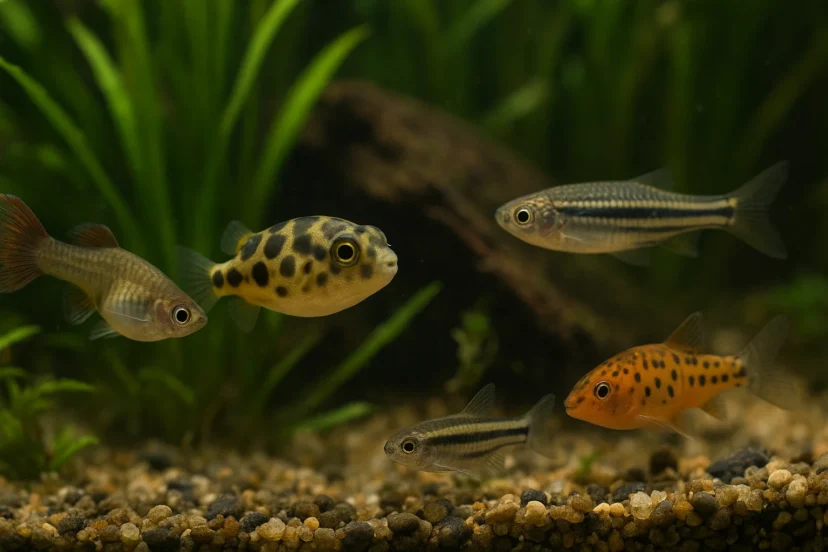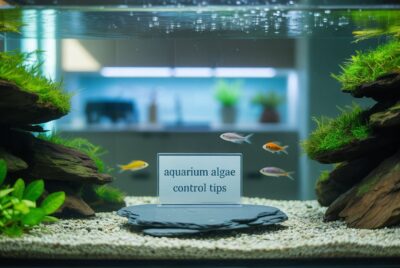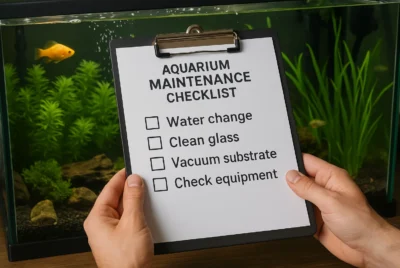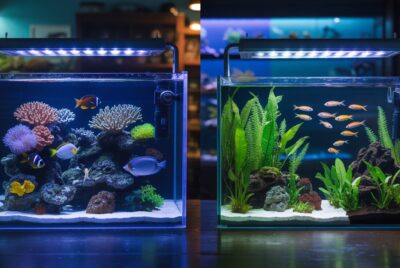Pea Puffer Tank Mates: The Complete Guide
*We may earn a commission for purchases made using our links. Please see our disclosure to learn more.
The day I brought home my first pea puffer, I was instantly captivated by its curious eyes and quirky personality. There it was, barely the size of my fingernail, darting around its new tank with unmistakable intelligence and attitude. I quickly learned that these tiny creatures, also known as dwarf puffers (Carinotetraodon travancoricus), pack enormous character into their diminutive bodies. But as my fascination grew, so did a pressing question: could my little puffer have companions, or was it destined for a solitary life?
Many aquarists face this same dilemma. Pea puffers have earned a reputation as the “angry jellybeans” of the aquarium world – adorable yet surprisingly territorial for their size. Their specific care requirements and semi-aggressive nature make choosing tank mates a delicate balancing act. After years of trial, error, and research, I’ve discovered that with the right approach, these miniature marvels can indeed share their space – though they’ll never be the most sociable fish in the hobby.
This guide draws from my personal journey of creating harmonious community tanks with pea puffers. I’ll share both my successes and my heartbreaking mistakes, offering practical advice for fellow enthusiasts who dream of a vibrant, multi-species aquarium that includes these fascinating little puffers.
“The dwarf puffer may be small in size, but it’s a fish with a giant personality and specific needs. Finding suitable tank mates requires understanding their territorial nature and providing proper space for all inhabitants to thrive.”
– Journal of Aquatic Sciences, Vol. 28
Key Takeaways
- Size Matters: Pea puffers require a minimum 10-gallon tank for themselves, with an additional 5-10 gallons for each potential tank mate species.
- Speed and Space: Ideal tank mates are fast swimmers that can evade puffers and occupy different areas of the tank.
- Similar Water Parameters: All inhabitants must thrive in the same water conditions (pH 7.0-7.6, temperature 74-82°F).
- Heavy Planting: Dense vegetation and hiding spots are essential for territory boundaries and stress reduction.
- Monitoring is Crucial: Regular observation for signs of aggression or stress among tank inhabitants is necessary.
Recommended Products for Pea Puffer Community Tanks
Fluval Plant 3.0 LED Light
The Fluval Plant 3.0 LED is a high-performance aquarium light designed for planted tanks, offering full-spectrum illumination to enhance plant growth and aquarium aesthetics. With customizable 24-hour light cycles and six unique band waves, this light provides optimal lighting conditions for a thriving aquatic environment. Its extendable mounting brackets ensure easy installation, making it a versatile choice for various tank sizes.
- Customizable Lighting: Features programmable 24-hour cycles, including sunrise, midday, sunset, and night modes.
- Full Spectrum Growth: Six unique band waves promote healthy plant growth and vibrant colors.
- Wide Coverage: 120-degree light dispersion ensures even illumination across the entire tank.
- Premium Price: Higher cost compared to basic aquarium lighting options.
- App-Dependent Controls: Requires a mobile app for full customization, which may not suit all users.
- Limited Waterproofing: Not fully submersible, so care is needed during maintenance.
A thriving planted environment is essential when housing pea puffer tank mates, as it offers natural hiding spots, reduces stress, and minimizes territorial behavior. The Finnex PX-150 filter helps support dense aquatic vegetation, ensuring stable water quality and oxygen levels needed for both your puffers and their compatible companions. Strong plant growth creates the perfect natural buffer, encouraging peaceful interactions and a balanced micro-ecosystem in your aquarium.
API Freshwater Master Test Kit
The API Freshwater Master Test Kit is a comprehensive and trusted solution for monitoring the health of your freshwater aquarium. With the ability to perform up to 800 tests, this kit includes everything you need: 7 bottles of testing solutions, 4 test tubes with caps, and a detailed color chart for accurate readings. It measures five critical water parameters—pH, high-range pH, ammonia, nitrite, and nitrate—ensuring your betta fish lives in clean, safe, and stable water conditions. Regular use of this kit helps prevent invisible water issues that can lead to stress, disease, or even loss of your fish.
- Comprehensive Testing: Covers all essential water parameters for freshwater tanks.
- Long-Lasting Value: Provides up to 800 tests, making it cost-effective over time.
- Accurate Results: Trusted by hobbyists and professionals for precise water readings.
- Manual Process: Requires measuring and comparing to color charts, which can be time-consuming.
- Storage Space: Comes in a relatively bulky box that may take up tank cabinet space.
- No Digital Display: Lacks digital convenience some modern testers offer.
Maintaining stable water parameters is crucial when keeping pea puffer tank mates in a shared aquarium. Pea puffers are sensitive to poor water quality, and their potential companions often require equally precise conditions. Regular monitoring of ammonia, nitrite, nitrate, pH, and temperature ensures a safe and balanced environment. This not only supports the health of your puffers but also helps reduce stress and aggression among tank mates by keeping the ecosystem stable and clean.
Seachem Flourish Excel
Seachem Flourish Excel is a premium liquid supplement designed to provide bioavailable organic carbon to your aquarium plants, essential for their growth and health. It also helps to reduce iron to a more plant-accessible ferrous state, supporting efficient nutrient uptake. This powerful formula aids in photosynthesis by bypassing the need for plants to produce longer carbon chain compounds. Ideal for planted aquariums, it is completely safe for fish and enhances overall plant vitality. Use it regularly for vibrant, thriving plants in your freshwater tank.
- Enhances plant growth: Provides an essential source of bioavailable carbon to support healthy plant development.
- Iron support: Helps plants utilize iron more effectively by converting it to a more absorbable form.
- Fish-safe: Safe for fish when used as directed, making it a reliable choice for planted aquariums.
- Not suitable for all plants: Certain species like Anacharis may require less frequent dosing to avoid negative effects.
- Requires regular dosing: Consistent application is necessary for optimal plant health.
- Potential for algae growth: If overused, it can lead to algae blooms in some aquariums.
Using a liquid carbon supplement is a simple yet effective way to enhance plant growth without the need for complex CO₂ injection systems. In tanks with pea puffer tank mates, dense and healthy plants play a vital role in creating natural territories, hiding spots, and reducing aggression. Liquid carbon fuels plant development, helping to outcompete algae and maintain a lush aquascape that supports a calm and stable environment for your puffers and their companions.
Finnex PX-360 Compact Canister Filter
The Finnex PX-150 Compact Canister Filter is a space-saving yet powerful filtration system designed for freshwater aquariums up to 30 gallons. With a 3-stage filtration process—carbon, floss, and ceramic rings—it efficiently removes waste, odors, and harmful chemicals, keeping your tank crystal clear. The included flow valve control allows you to fine-tune water movement for delicate fish and plants. Ideal for nano tanks and hobbyists looking for high performance in a compact size.
- Efficient Filtration: 3-stage media ensures thorough mechanical, chemical, and biological cleaning.
- Adjustable Flow: Flow valve makes it easy to control water movement to suit your tank's needs.
- Compact Design: Saves space and fits easily beside or behind smaller aquariums.
- Noisy Operation: Some users report it can be louder than expected during long use.
- Not Ideal for Heavily Stocked Tanks: May struggle in tanks near the upper gallon limit if overstocked.
- Basic Setup Instructions: Assembly directions could be clearer for first-time users.
The right filtration system is essential for maintaining water quality and reducing stress in pea puffer community tanks. For tanks between 10 and 20 gallons, this filter offers just the right balance of power and gentle flow, ensuring clean, oxygen-rich water without disturbing delicate plants or small tank mates. Ideal for aquariums housing pea puffer tank mates, it helps support a peaceful, stable environment where all species can thrive.
Understanding Pea Puffer Behavior
My first attempt at keeping pea puffers with other fish was nothing short of disastrous. Enticed by their tiny size, I naively added three puffers to my established community tank with neon tetras and guppies. Within days, I noticed tattered fins on my guppies and increasingly stressed behavior from all inhabitants. The puffers had established territories and were fiercely defending them against fish many times their size.
This experience taught me the importance of carefully selecting pea puffer tank mates. Pea puffers are naturally territorial and can be aggressive despite their small size. In the wild, they inhabit densely vegetated waters in Kerala, India, where they claim small territories and defend them with remarkable determination. Males are particularly territorial during breeding seasons, while females tend to be slightly more tolerant.
Their intelligence sets them apart from many other nano fish. Pea puffers recognize their keepers, exhibit problem-solving behavior, and have distinct personalities. This intelligence, while endearing, also means they quickly learn that slower tank mates make easy targets—highlighting the need to choose pea puffer tank mates wisely.
Another crucial aspect of their behavior is their hunting instinct. As micropredators, pea puffers naturally hunt small invertebrates. This predatory nature makes them a threat to shrimp, snails, and other slow-moving creatures. I learned this lesson the hard way when my thriving cherry shrimp colony disappeared mysteriously after introducing puffers – a costly mistake both financially and emotionally.
The Perfect Tank Setup for Cohabitation
After my initial failures, I realized that creating a successful community tank with pea puffers requires careful planning. The key elements are:
Tank Size and Layout
The single most important factor in successful cohabitation is adequate space. For a community tank with pea puffers, I recommend no less than 20 gallons, preferably a long tank rather than a tall one. This provides sufficient swimming space and territory for all inhabitants.
My most successful setup was a 29-gallon heavily planted tank with a footprint of 30″ x 12″. This allowed me to create distinct territories with natural boundaries, significantly reducing aggression. The extra swimming space meant faster fish could easily escape if a puffer became territorial.
Vegetation and Hiding Spots
I cannot overemphasize the importance of dense planting. My breakthrough moment came when I transformed my half-planted tank into a veritable underwater jungle. I used fast-growing stem plants like Hygrophila and Rotala for background coverage, midground plants like Cryptocoryne wendtii, and foreground carpeting plants like Java moss.
Floating plants like frogbit and water lettuce provide additional coverage while creating subdued lighting that makes puffers feel more secure. Driftwood, rock formations, and ceramic caves offer essential hiding places for all tank inhabitants.
When I added ceramic caves strategically throughout the tank, I noticed each puffer claiming a particular cave as its territory, significantly reducing squabbles over space.
Water Parameters and Maintenance
Maintaining pristine water conditions is crucial. Pea puffers are sensitive to poor water quality, as are many of their suitable tank mates. I maintain:
- Temperature: 76-78°F
- pH: 7.2-7.4
- Ammonia and Nitrite: 0 ppm
- Nitrate: Below 20 ppm
Weekly water changes of 25-30% help maintain water quality. I found that a powerful filtration system rated for tanks slightly larger than mine helps manage the bioload, especially important because puffers are messy eaters.
Compatible Tank Mates: My Successful Combinations
After much experimentation, these are the pea puffer tank mates that have worked well:
1. Otocinclus Catfish
These peaceful algae eaters occupy a completely different niche than puffers. They spend most of their time attached to surfaces, cleaning algae from plants and glass. Their quick movements and tendency to stay out of the puffers’ way make them excellent companions. In my experience, a group of 5-6 otocinclus in a 20+ gallon tank works well with 3 pea puffers.
One challenge I faced was ensuring adequate food for the otos, as they primarily eat algae. I supplemented with blanched zucchini and specialized algae wafers placed in areas away from the puffers.
2. Small Rasboras
Boraras rasboras (like chili rasboras and phoenix rasboras) have been my most successful schooling fish companions for pea puffers. Their tiny size might seem counterintuitive, but their quick movements and tendency to stay in the upper water column keep them safe from puffer aggression.
I keep a school of 12-15 chili rasboras with my puffers. The vibrant red coloration of the rasboras adds a stunning visual element without triggering the territorial response from puffers that similarly-shaped but more colorful fish like guppies might.
3. Kuhli Loaches
These peaceful bottom-dwellers have coexisted peacefully with my puffers for years. Their nocturnal nature means they’re most active when puffers are resting. Additionally, their snakelike appearance doesn’t register as competition to the puffers.
I keep a group of 6 kuhli loaches, providing them with a fine sand substrate and plenty of hiding places among driftwood roots. The loaches help clean up food scraps from puffer feedings, contributing to overall tank cleanliness.
4. Certain Neocardina Shrimp (With Caution)
This remains controversial in the hobby, but I’ve had limited success keeping some hardy shrimp species with pea puffers in heavily planted tanks. The key has been creating extremely dense moss areas where adult shrimp can hide safely.
I introduced a colony of blue dream neocaridina when my plants were already well-established. While I accept some shrimplet predation as inevitable, the adult population has maintained itself as they can hide effectively in the dense vegetation. This balance works only in larger tanks (30+ gallons in my experience) with exceptionally heavy planting.
Tank Mates to Absolutely Avoid
Learning which species to avoid has come through painful experience. These are the tank mates that have consistently failed in my pea puffer community attempts:
1. Slow-Moving or Long-Finned Fish
Bettas, fancy guppies, and angelfish are prime targets for fin-nipping. In my early attempts, a beautiful male betta lasted just two days before his flowing fins were severely damaged by curious puffers. These species are simply too tempting and too slow to escape pesky puffers.
2. Small Invertebrates
Despite my limited success with established neocaridina colonies, most snails and dwarf shrimp species will become expensive puffer food. My first cherry shrimp colony disappeared within days, teaching me an expensive lesson about puffer dietary preferences.
3. Other Puffer Species
While multiple pea puffers can sometimes coexist (with sufficient space and females outnumbering males), mixing different puffer species is asking for trouble. Figure-8 puffers and green spotted puffers have different care requirements and will outcompete the smaller pea puffers for food and territory.
4. Bottom-Dwelling Fish That Compete for Space
Corydoras catfish, while peaceful, occupy the same tank level and searching territory as pea puffers. My attempt at keeping corys with puffers resulted in stressed catfish that were continuously chased away from their feeding areas.
Introducing New Tank Mates: The Right Approach
The method of introduction can make or break a community tank with pea puffers. Through trial and error, I’ve developed this approach:
Puffers Last, Not First
The most successful strategy is adding pea puffers as the final fish in an established community. This prevents them from claiming the entire tank as territory. When I added rasboras to an established puffer tank, the puffers were much more aggressive than when I added puffers to an existing rasbora community.
Rearranging the Tank
When introducing puffers to existing fish, I completely rearrange the tank decorations and plants right before adding them. This temporarily disrupts all established territories, putting everyone on equal footing and reducing defensive aggression.
Proper Acclimation
I use a slow drip acclimation method for all new fish, especially sensitive species like pea puffers. This reduces stress during transition, which can otherwise trigger aggressive behavior.
Feeding Distraction
When adding new fish, I simultaneously add food in multiple areas of the tank. This distracts the existing inhabitants and associates the new arrivals with positive experiences rather than territorial threats.
Managing Potential Conflicts
Despite best efforts, conflicts can arise in any community tank. Here’s how I handle potential problems:
Visual Barriers
When I noticed one particularly territorial female puffer harassing my otocinclus, I added more tall plants to break up sight lines across the tank. This simple addition reduced chasing behavior significantly, as the puffer would lose sight of the “intruder” after a short chase.
Multiple Feeding Stations
Competition for food can trigger aggression. I feed my community tanks using at least three separate feeding areas simultaneously. For puffers, I target-feed frozen bloodworms using a pipette, while simultaneously adding flake food for the rasboras at the surface and sinking pellets for bottom dwellers.
Removal When Necessary
Sometimes, despite our best efforts, a particular fish may prove too aggressive. I maintained a separate 5-gallon species-only tank for one especially territorial male puffer who simply couldn’t adapt to community life. Recognizing when a fish needs dedicated space is part of responsible fishkeeping.
Common Challenges and Solutions
Throughout my years keeping pea puffers in community settings, I’ve encountered several recurring challenges:
Challenge 1: Aggression During Feeding Time
Puffers become particularly territorial during feeding. I solved this by using a feeding ring for surface feeders at one end of the tank while target feeding the puffers at the opposite end. Additionally, feeding small amounts twice daily rather than one large feeding reduced competition.
Challenge 2: Maintaining Plant Health
The heavy planting necessary for successful communities requires careful attention to plant health. When my plants started struggling, puffer aggression increased almost immediately. I invested in a high-quality LED light and regular fertilization schedule, which maintained the dense vegetation necessary for harmonious cohabitation.
Challenge 3: Balancing Bioload
The combination of messy puffer feeding and multiple species can quickly lead to water quality issues. Upgrading to a canister filter rated for a tank twice my actual size, combined with weekly water changes, kept parameters stable even with the increased bioload of a community setup.
Challenge 4: Treating Disease Without Harming Sensitive Species
When I needed to treat a bacterial infection, I faced the challenge that many medications are toxic to invertebrates and harmful to puffers. Setting up a hospital tank became essential for treating individual fish without compromising the community.
The Emotional Rewards of Success
After numerous attempts, failures, and adjustments, finally establishing a balanced community tank with pea puffers brought incredible satisfaction. Watching my tiny puffers curiously investigate but ultimately accept their tank mates created a fascinating dynamic aquarium. The contrasting behaviors, colors, and movement patterns create a living ecosystem that’s far more engaging than a single-species tank.
The challenge itself became rewarding – solving the puzzle of compatible personalities and creating environments where different species could thrive together. Each small success, like seeing a puffer swim calmly past a rasbora without giving chase, felt like a personal accomplishment.
Most importantly, a well-established community tank with pea puffers provides a more enriching environment for the puffers themselves. They display more natural behaviors, exploring their environment with the confident curiosity that makes these fish so endearing.
Conclusion
Creating a community tank with pea puffers is undoubtedly challenging, but with careful planning, appropriate tank mates, and abundant space and vegetation, it’s absolutely achievable. The key lies in understanding puffer behavior and creating an environment where all species can establish their territories without constant confrontation.
Through my journey of successes and failures, I’ve learned that pea puffers can indeed coexist with carefully selected tank mates, creating a dynamic, engaging aquarium that showcases the best qualities of each species. While not every attempt will succeed, and individual fish personalities play a significant role, the guidelines I’ve shared represent my best experiences in creating harmonious pea puffer communities.
If you’re considering adding these charismatic “angry jellybeans” to a community setting, approach the task with patience, flexibility, and a willingness to adapt. The reward – a thriving, peaceful community with these fascinating fish – is well worth the effort.
Frequently Asked Questions
Q1: How many pea puffers can I keep together in a community tank?
A: For a community setup, I recommend starting with just 2-3 pea puffers in a 20-gallon or larger tank. Females are generally less aggressive than males, so a ratio of 2 females to 1 male works well if you want multiple puffers.
Q2: Can pea puffers live with bettas?
A: Based on my experience, this combination is risky and not recommended. Both species are territorial, and puffers will likely nip at the betta’s flowing fins. Additionally, both species prefer similar territories, creating competition and stress.
Q3: Do I need to feed my pea puffers snails to keep their teeth trimmed?
A: While pea puffers do have teeth that grow continuously, they don’t require hard-shelled foods like larger puffers do. Their natural diet consists primarily of soft-bodied invertebrates. I’ve maintained healthy pea puffers for years on a diet of frozen bloodworms, daphnia, and occasional small snails without dental issues.
Q4: How can I tell if my tank mates are stressed by the pea puffers?
A: Watch for hiding more than usual, decreased appetite, rapid gill movement, and fin clamping. Fish that constantly stay in upper corners or hide behind filter outflows are showing signs of stress and the situation should be addressed immediately.
Q5: Can I add pea puffers to my planted shrimp tank?
A: This combination is extremely risky. While some heavily planted tanks with established adult shrimp colonies can maintain a population with puffers, you should expect significant predation of juvenile shrimp. Only attempt this in very large, extremely heavily planted tanks, and only if you’re willing to accept some shrimp losses.













